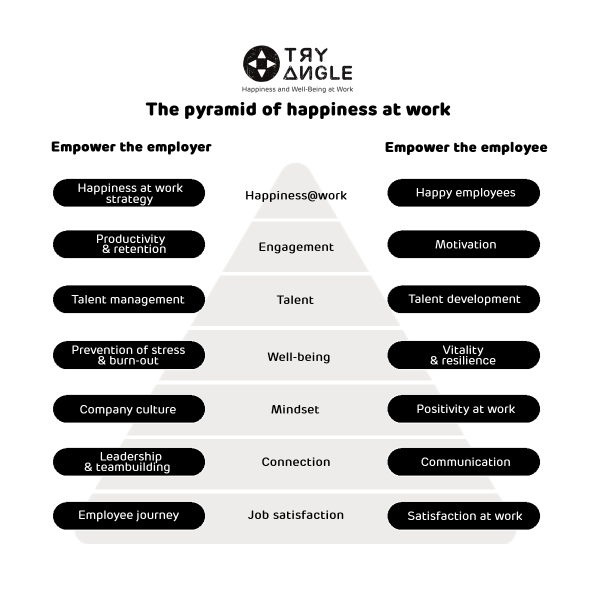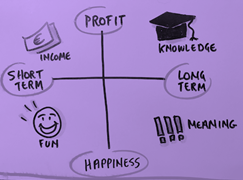 English
EnglishThe 5 biggest misconceptions of happiness at work
Just at the end of 2019, and thanks to Lesley Arens of #ZigZagHR, I had the opportunity to read an online article that had quite an impact on me. The article, written by Dr Tomas Chamorro-Premuzic was stacked with tons of misconceptions about happiness at work. As Chief Talent Scientist at Manpower Group, a professor in Business Psychology at the University College of London and at Columbia University, he happens to be an author of numerous bestsellers. Safe to say he is considered a true authority in his field. Yet, I wouldn’t mind challenging this article as it states “Fire your Chief Happiness Officer”. It’s an impressive collection of misconstrued statements on happiness at work. As this happens to be my field of expertise, I definitely would like to contest five of his most exceptional statements:
MISCONCEPTION 1: The focus of HR is shifting from productivity to personal well-being and happiness
Dr Tomas states: “Conversations about talent have steadily shifted from productivity and career success to personal well-being and happiness. The underlying premise is that employees need to prioritize their own happiness over other career goals.”
I am quite curious about the HR conversations on talent that Dr Tomas is having. In Belgian organisations, talent unfortunately is far from being the main topic. Companies still mainly focus on competence management and even if talent management themes are starting to emerge, it never ceases to include the company’s productivity focus. And yes, focusing on talent does have a positive impact on the employee’s productivity, which brings us to the domain of happiness at work. Stating that our premise is that employees are supposed to put their own personal happiness before career goals is quite a bridge too far. Actually, it’s a concept no one in the field is actually considering. Moreover, I’m not really seeing a shift from one area to another, rather than the widening of the field. Companies are looking at both ends of the spectrum, and are discovering how they can reinforce one another. Employees are becoming more productive by focusing on their talents. At the same time this is beneficial for their personal well-being and happiness, which creates even higher productivity and hence constitutes a positive spiral.
MISCONCEPTION 2: The search for happiness is being incorrectly used as a synonym for engagement. Moreover, happiness does not lead to higher productivity.
The article states: “In fact, “engagement” is shorthand for a set of factors that are often mistaken as synonyms for “happiness”. Unlike engagement, however, happiness doesn’t translate into higher levels of performance or productivity.”
I would love to explore the sources Dr Tomas used to come to the conclusion that happiness at work doesn’t lead to higher productivity! All over the world, research after research has been executed with impressive results: happiness at work increases productivity and has a long list of other positive effects. Looking at the Gallup research from 2017, investing in happiness at work resulted in a 22% productivity increase. The business case on happiness at work from Hutten in the Netherlands in 2018 had employees reporting 50% more engagement and 31% more productivity.
Want to talk about other ‘performance’ aspects? We can! Looking at absence rates, a very straightforward indicator, the numbers aren’t hard to find: investing in happiness at work leads to a decrease of absenteeism issues: Forbes concluded a 66% decrease in illness related absence and Harvard Business Review reported a burn-out rate decrease of 125% (!!) for organisations that work on happiness at work.
Next to the effects on absenteeism, happy companies also suffer less from presenteeism. SPMT-Arista has concluded that “Presenteeism, even though it’s a less obvious factor, has even more significant consequences than absenteeism. It refers to the decrease of productivity because of (psychological or physical) health issues from active employees. Paul Hemp has estimated the productivity rate to drop with 7,6%, which makes it three times more impactful than the absenteeism issue.”
MISCONCEPTION 3: Feeling unhappy is what motivates people to move forward. Anyone who is entirely contented will no longer feel the need to innovate.
This paragraph was a true jaw-dropper for me: “a relative degree of dissatisfaction will boost productivity and performance more than happiness does. Nothing of value would ever be created unless people are somewhat unhappy and therefore motivated to change their state of affairs. Anyone who’s entirely contented is unlikely to innovate.”
Reading a conviction of medieval proportions like this one, makes me feel the need to repeat the very basics once more. Let me clarify that we are talking about “happiness at work”. A professional concept and subject to ample scientific research, referring to aspects such as results and relationships at work. Professionals in this field are not talking about a fluffy and hard to grasp emotion of happiness. It’s quite important not to mix these two up in an professional context. A CHO doesn’t.
And if I understand Dr Tomas correctly, he seems to think that I need to be just a tad unhappy in order to be motivated to act. Not in my boat! We are living in the year 2020 and intrinsic motivation has been the subject of widespread and extensive research. And talking about motivating factors, both “improving a current situation” and “using ones talents to contribute to a bigger goal” are both perfectly valid concepts. And the latter certainly doesn’t contain a condition of unhappiness.
Of course, we have to allow room for a bad day or unhappy emotions. Happiness at work does not refer to a “happy state of mind 24/7”. In fact, happiness at work specifically leaves room for the person behind the job title. Organisations with a culture that nurtures happiness at work allow for employees to experience negative emotions. However, the way Dr Tomas is describing it (“Anyone who’s entirely contented is unlikely to innovate”), is more of an invitation for the employer to specifically cater to a whiff of unhappiness as a motivational strategy. The unstoppable burn-out epidemic that we are facing today surely does not advocate for such a negative strategy. Happiness at work is a shared responsibility between the employee, the line manager and the employer, and it requires all of them to play a sincere role and with nothing but the most positive intentions.
MISCONCEPTION 4: We are all encouraged to find our dream job, but it’s simply not possible for everyone.
And again I’m quite amazed when reading this paragraph: “You can’t expect your job to make you happy, it’s unfair pressure on the average employee to find their “dream job”. Only a small handful of the modern workforce can ever hope to partake of such vocational adventures; the rest are left to fight for unexciting, bills-paying employment, often with incompetent bosses who alienate and stress them out.”
Let’s look at the pyramid of happiness at work that my colleagues and myself at Tryangle have developed.


Finding meaning, much like Maslov’s self-realisation concept, is at the top of the pyramid. However, it’s important to understand that working on happiness at work is possible by working on any level of the pyramid. In my job as a Chief Happiness, I meet people every day that have all kinds of jobs and different responsibilities. On every level and for every job title, I have met people who were either completely miserable or who were ecstatic to have found the job of their lives. One of the important defining factors in their conclusions is the way they look at their situation. Health economist and happiness professor Lieven Annemans has developed the ABC of happiness (at work) designed to reset a person’s point of view. The ABC of happiness (at work) refers to autonomy, involvement (“betrokkenheid” in dutch) and competence. And even if a person doesn’t have full control over all aspects – the influence of a line manager for example can play a major role in how an employee performs and feels – at the end of the day the personal mindset determines if the overall scale is tipped to the positive or negative side.
Of course, there are always situations where employees are confronted with very real limitations that makes it (look) impossible for them to leave their crappy job. Even in these circumstances, the concept of working on someone’s happiness at work allows for the individual to make more conscious choices. There’s always a way to work on feeling a bit better in the environment they’re in. Even in a job that looks like the end of the world, for whatever reason. After all, it can be a dream job and a great opportunity for someone else.
MISCONCEPTION 5: Happy work places are cosy and fun, but there is no time to be productive.
Excuse me? “It’s not hard to imagine happy work environments where employees are having way too much fun to be productive; too much getting along can inhibit getting ahead.”
It’s both hilarious and extremely sad to see that a university professor in business psychology does not separate the concept of “sustainable happiness at work” from short term fun initiatives. The exact reason why companies that offer services on corporate well-being and happiness at work have emerged, is their focus on the overall ROI for profit-driven organisations (such as increased productivity and other positive effects). Much too often, we see companies get themselves into trouble with fun activities such as yoga lessons during lunchtime or teambuilding activities where co-workers can shoot paint bullets at each other, all in the hopes of increasing teamwork. Info-flash: that’s not going to happen!
It certainly won’t happen if companies keep investing in one-shot initiatives and fun freebees that are not tied back into a bigger picture: a longer term culture of happiness at work where cooperation, resilience, talent development, etc are nurtured. And info-flash number 2: a CHO’s job has nothing to do with planning the fun stuff. Plenty of organisations have a party committee or feel good ambassadors that focus on the fun. And if these activities are part of a bigger long term strategy, then the CHO will have a much easier job.


Not having a long term view means a company is not investing in sustainable happiness at work. Leo Bormans mentioned this during his keynote of the Closure Event of the International Week of Happiness at Work in Brussels in September 2019: A sustainable and long term strategy for happiness at work, and the key responsibility of the CHO, is all about creating meaning.
Companies where everyone is only having fun and chatting the day away would most probably even have higher turnover than average. But as far as I know, there is no research that supports such a statement, so I can’t be sure. But as opposed to Dr Tomas, I’d prefer not to make statements that aren’t backed up by scientific research.
To be honest, I’m not done countering the many other misconceptions on happiness at work that can be found in this article from Dr Tomas. It’s quite a pity that with the knowledge and insights that are currently available, shortsighted and untrue content is being put out there. Everyone is entitled to their opinions, but I’d love to support science over personal convictions and nuance over one-sided polarization that is merely aimed at discrediting the concept of happiness at work and the work of so many Chief Happiness Officers.
I’d love to invite Dr Tomas – and everyone else who wants to join the discussion – to spend some time with one of my customers and put those opinions on the daily tasks and challenges of CHOs to a reality test. And if afterwards, you still agree that the CHO role is an abundant one, than I’d love to engage in a well-argued professional debate.

